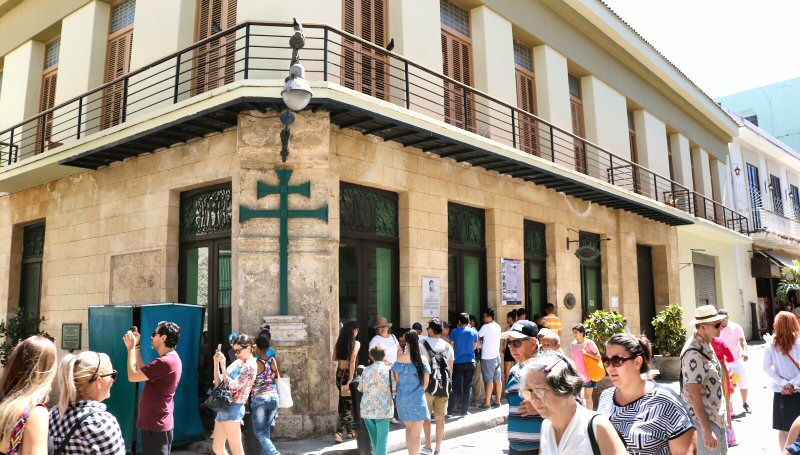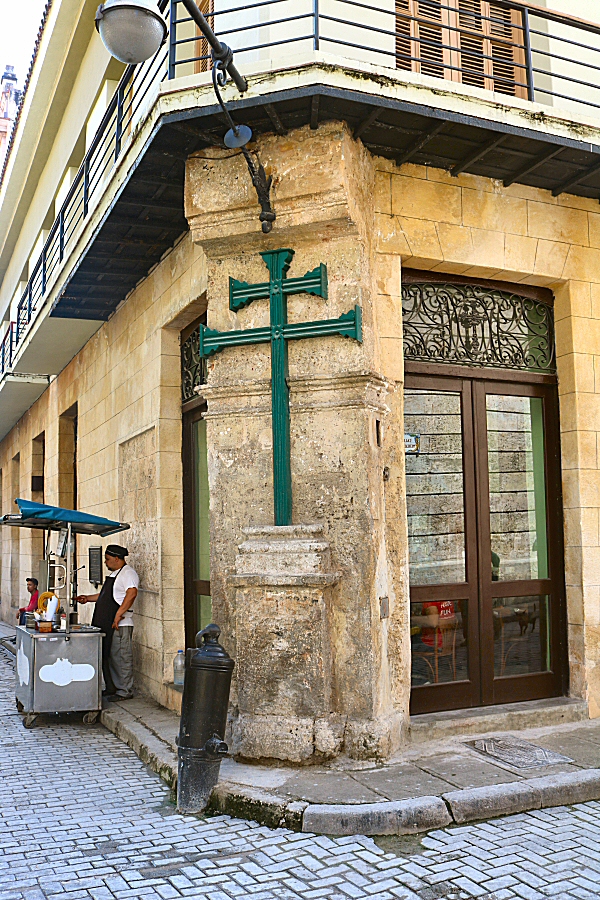

The Museo del Chocolate is located on the Mercaderes street #253, where it intersects the Amargura street.
The Casa de la Cruz Verde is a two-storey building with the balcony, encircling the whole facade with black iron fence. The upper floor was used as residence, and the ground floor was reserved for commerce. The building has not any distinctive characteristics, except the green wooden cross on the wall at the corner that arrived from the 18th century until our days. It is made of cedar and has a nice chamfered form, standing on a carved stone support. This two-barred cross is related to the celebrations of Vía Crucis that was a Catholic procession to reproduce the martyrdom of Jesus from the Praetorium (the Roman Governor’s residence) to Calvary (Golgotha; the place where Jesus was crucified).
The Catholics in Havana were paying tribute to the image of the Cristo de la Vera Cruz in the chapel of the Third Order of San Francisco (La Capilla de la Santa Veracruz), built as the adjoining building of the Basilica Menor de San Francisco de Asís in 1608. Cristo de la Vera Cruz (Christ of the True Cross) is an invocation of Christ that can correspond to different images.
Towards the year of 1640, the ritual became more demonstrative in Havana. La Capilla de la Santa Veracruz marked the starting point for the procession of the Vía Crucis or the Camino a la Cruz (the Path to the Cross). The Vía Crucis that refers to the passage of Jesus from the Praetorium to Calvary, is the theme of one of the oldest devotions, practiced by the Catholics around the world. This devotion spread throughout Europe by the Franciscan friars that were in charge of the holy places in Palestine since the 13th century and imported to Cuba by the Spanish during the time of the Christianization of the New World throughout the 16th to 18th centuries. It reviews the 14 stations in the final hours of Jesus, from the moment that he was apprehended until his crucifixion and the burial. The path is represented by a series of images of the passion, called stations, that correspond to the incidents that Jesus suffered for the salvation of the humanity.
Each Friday of Lent the image of the crucified Jesus was taken out from the chapel and led down to the Iglesia del Santo Cristo del Buen Viaje in the Plaza del Cristo, passing through the Amargura street. The corners of the Amargura street where it intersects other streets along the Vía Crucis were given the names of the 14 stations and their respective images, such as the Cruz Verde (Mercaderes street), Cristo del Zapato (Cuba street) and Mujeres Piadosas (Aguacate or former Avocado street). The devotion was accomplished by walking through the Amargura street, stopping at each station and making a prayer by imploring on the knees in front of the cross and making a reading about the passage of the gospel to remind the way of Jesus to Calvary. This ceremony was held especially at night, when the churches were closed. The Amargura street (in Spanish sorrow, grief) was called successively De las Cruces, De las Cruces del Calvario and De la Cruz Verde. Eventually, more than fifty crosses emerged in the city, such as in the Villegas and the Compostela streets, as well as in other streets of the Old Havana.
The Via Crucis was suspended in 1808, when the Bishop Juan José Díaz de Espada y Fernández de Landa prohibited it. By passage of time all the crosses that existed along the Amargura street disappeared, except the Green Cross at the corner of the Mercaderes street. The Cruz Verde that was placed in 1740, was the first and the last of those crosses. The custom of crossing oneself in front of the Green Cross continued for some people well into the 20th century. The last Vía Crucis in Havana that was suspended after 1961, took place in 2005.
In 1996 the Green Cross underwent a restoration process, in which a part of the cedar wood was replaced, as it was in bad condition. The reason of the green color of the cross is still unknown, although it is argued that the green color is associated with hope, spiritual initiation and the triumph of life over death.
The double cross can be observed in some charity stamps in Cuba between 1928 and 1958. Their sale was intended for the protection of poor children against tuberculosis and the construction of hospitals for children.
Casa de la Cruz Verde (House of the Green Cross)
Cruz Verde (Green Cross) and Vía Crucis (Way of
the Cross)

